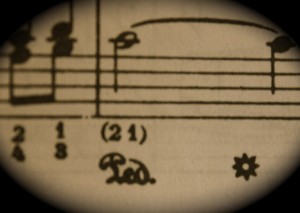Ped *ing
- a warning posted to prevent you from running over people crossing the street
- a sign to press and release the damper (right) pedal
- a diode that emits light
- what Moses did for the Israelites
- a very small sock for ladies
- a sign to keep your foot on the floor come what may
Remember the old Bugs and Daffy cartoons where Bugs repeatedly tricks Daffy into saying “Shoot me now, shoot me now” and finally when Daffy realizes the trick he responds, “Ahh, Pronoun Trouble” in measured tones (followed by name calling- generally “You’re despicable!”)?
A while ago, during a lesson, a college student and I were working on pedaling in a Field Nocturne and I was having trouble understanding why he wasn’t following the pedaling on the page (Ped *). Finally, he said something like, “then why does it say Led and what are those random asterisks?” “Ahh, I said, Font Trouble.”
After we sorted out the fact that what he was seeing was actually an uppercase P and not and L, he told me that he had a friend who also thought the signs read Led. Since then, (in what can only be called cosmic unity) I have encountered the same situation with two other advancing students.
Is the computer generation so inundated with the likes of Ariel and Times New Roman that they are unable to recognize letters in other more ornate fonts? It is true that I had to go through my Mac’s quite extensive font list one by one and only found a single font (Snell Roundhand Black) that reasonably matched the font used in the score in question. However, the edition was from a well known publisher and similar fonts are used by other publishers.
The sign, of course, does not read or mean Led (although the analogy is somewhat humorous in the light of some people’s lead-footed approach to pedaling in which the aim seems to be to change it as little as possible). The first letter is an ornate upper-case P and not an L (OK- I admit does look like an L – hence the “Font Trouble”). Ped is, in reality, an abbreviation of the word Pedal. When you see the Ped, you put the right (damper) pedal down or change it. The asterisks or * are signs to release the pedal completely.
Somehow students are missing out on the fact that there are two different methods of notating pedaling. Many modern editions use only graph style pedal notation. Some editors even change the notation of the composer from the Ped * style to graph style. Surely Ped * is not outdated and old fashioned or simply too European? It is, after all, found in the piano works of Aaron Copland, Richard Danielpour, Vincent Persichetti, and Ellen Taaffe Zwilich.
I think from now on, when I work with intermediate students on marking in pedaling, that I will be sure they can mark in pedaling graph style and Ped* style (and that they don’t have a lead-foot- but that is, of course, another blog…).



